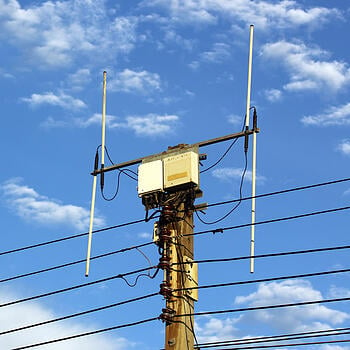DAS: The Next Great Attachment Race
 DAS is a hot button topic for some utility pole owners, and a growing issue in the world of joint use. Short for “distributed antenna system”, DAS is a network of antenna nodes often attached to utility poles to provide wireless service to a specific geographic area or structure. The service DAS offers is a growing want in metropolitan areas and small towns alike, as private companies and even neighborhoods seek to feed the growing desire for always-on high speed wireless access to smart phones, laptops, tablets, televisions, and even connected appliances.
DAS is a hot button topic for some utility pole owners, and a growing issue in the world of joint use. Short for “distributed antenna system”, DAS is a network of antenna nodes often attached to utility poles to provide wireless service to a specific geographic area or structure. The service DAS offers is a growing want in metropolitan areas and small towns alike, as private companies and even neighborhoods seek to feed the growing desire for always-on high speed wireless access to smart phones, laptops, tablets, televisions, and even connected appliances.
If utility pole owners ever doubted that the tide was turning toward increased DAS attachment, they need only look at the FCC’s own correspondence. In early 2014, the FCC released a broadband deployment proceeding, which proposed to speed up the deployment of DAS and small cells through an exemption from the National Environmental Policy Act of 1969. The new ruling overturns concerns about DAS previously based on large cell wireless installations and affects on wildlife. In their ruling, the FCC noted, “The increasing demand for advanced wireless services and greater wireless bandwidth is driving a need for additional infrastructure deployment and new infrastructure technologies. To meet localized needs for coverage or increased capacity in outdoor and indoor environments, many wireless providers are turning in part to small cell technologies and DAS.”[1]
Why be concerned? The issues with DAS are varied. Some concerns worth considering:
Space on existing poles
Utility poles are prime real estate in our tech-hungry world. DAS attachments will compete with all manner of equipment already on poles from cable television to broadband to telephone and beyond, and there is only so much room available. The fix? Conduct a thorough field inventory to know exactly what equipment is on poles and how much room is left and where to safely accommodate DAS.
Volume
With the popularity of DAS systems increasing, attachment requests may hit previously unheard of levels for pole owners not used to so much activity. Keeping ahead of demand—and not creating annoying backlogs—is key. The fix? Use a robust joint use communication system to keep attachment and transfer requests along with everything else relating to joint use process and procedure—organized and under control.
Bad Reputation
DAS did not enjoy a favorable introduction in the joint use world. When first introduced, unlawful, unregulated attachments created an environment of mistrust on the part of pole owners, along with NESC violations on the poles. We all hope history does not repeat in this respect, and that attaching companies will do better to honor pole owner requirements. The fix: Best practices, including field inventory and good record keeping to banish bootlegs, along with streamlined communication with attaching companies facilitated by a smart joint use management solution designed to keep contacts and contract information close at hand.
[1] http://www.aglmediagroup.com/fcc-proposes-streamlining-small-cell-das-deployments/

Comments